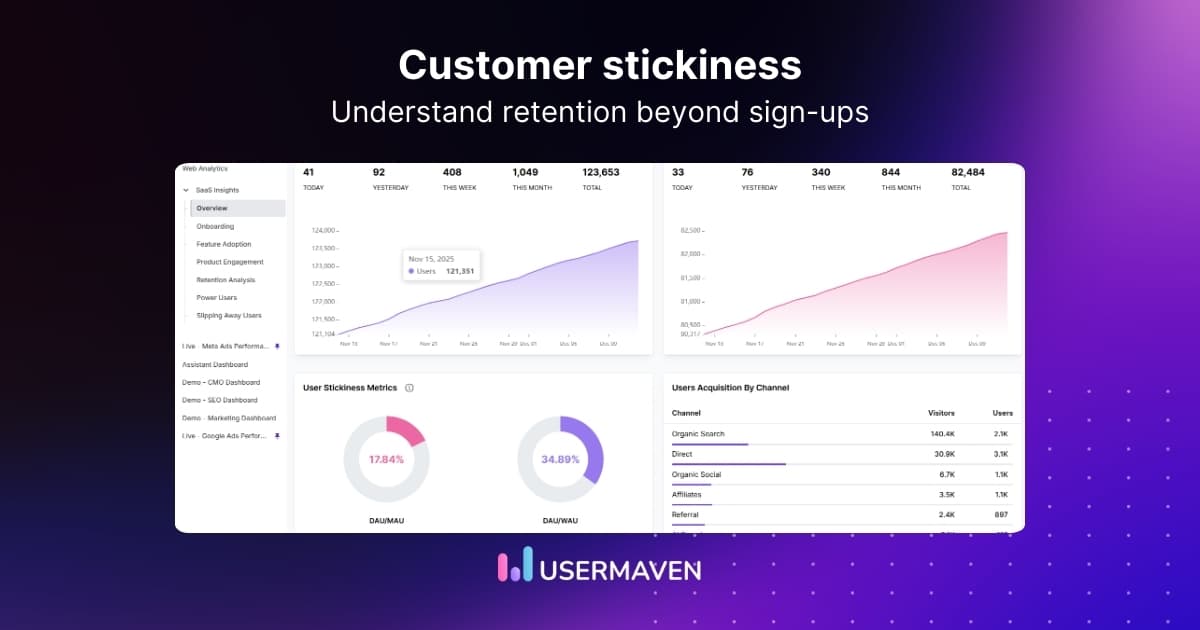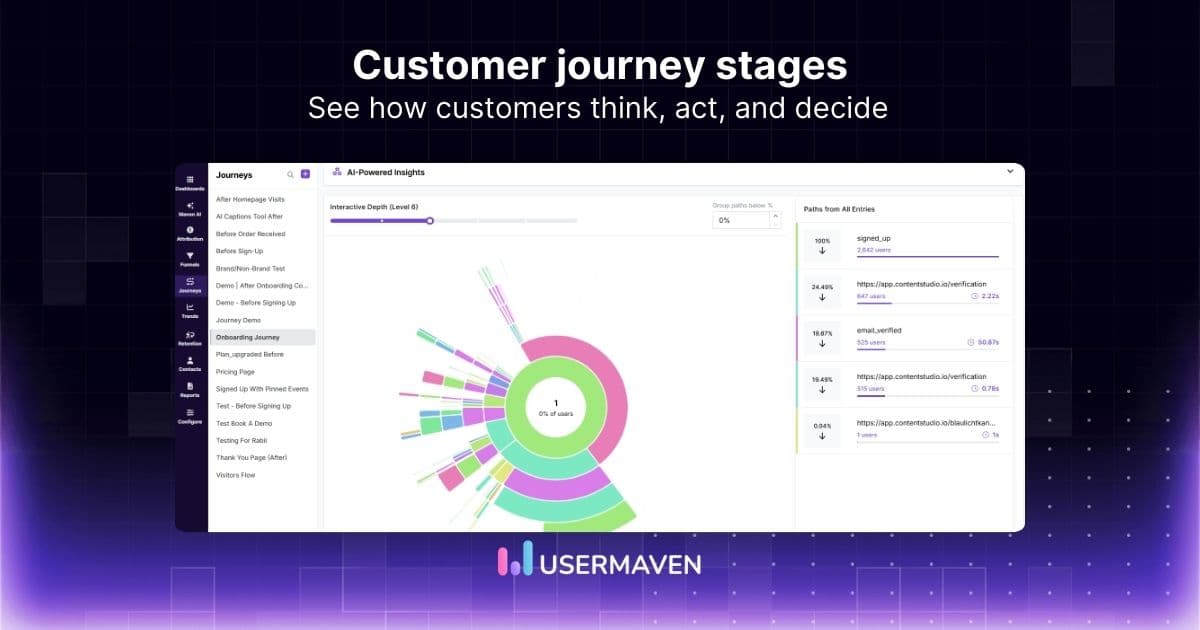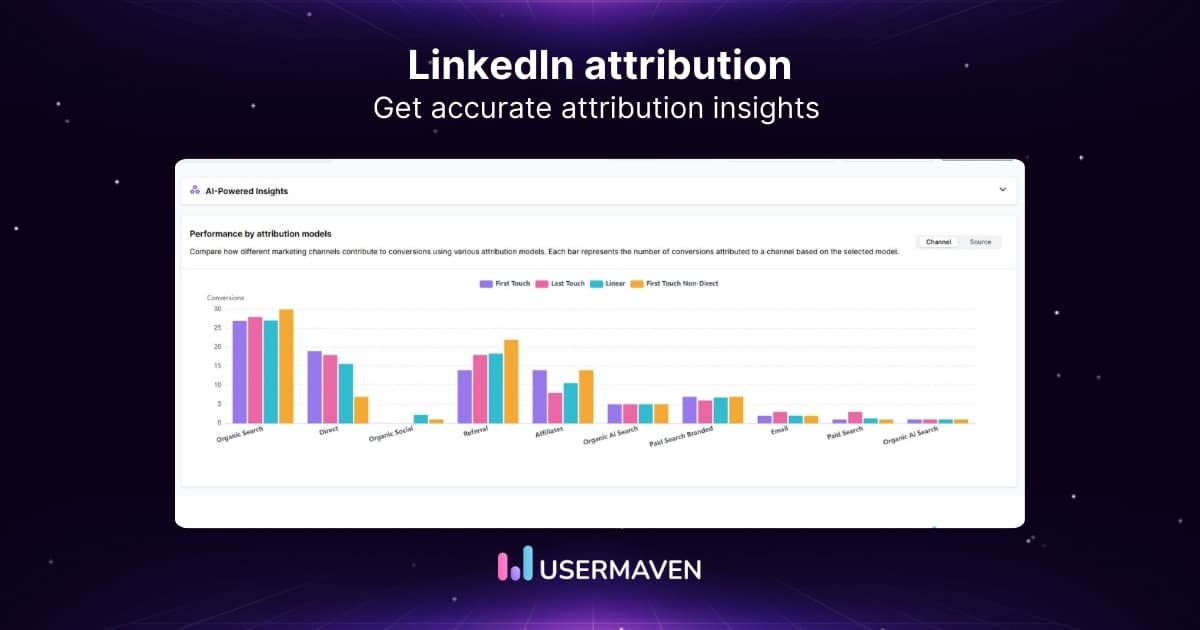Table of contents
What is a sales funnel? Strategies, stages & how to create one
Jan 13, 2025
8 mins read
Written by Arslan Jadoon

When it comes to converting casual browsers into loyal customers, businesses often face a challenging yet crucial question: How do you guide potential buyers from discovering your product to making a purchase? The answer lies in a well-structured sales funnel.
A sales funnel isn’t just a buzzword in marketing; it’s a proven framework that transforms interest into action. By breaking the customer journey into actionable stages, businesses can effectively nurture prospects and drive conversions. Whether you’re a SaaS founder, a digital marketer, or a product manager, mastering this process can bring clarity to your strategy and more predictability to your results.
In this guide, we’ll dive deep into what a sales funnel is, why it’s important, and how you can create one step by step. From understanding each stage to optimizing performance using tools like Usermaven, you’ll learn how to craft a funnel that supports sustainable business growth. Let’s explore the insights that can turn potential customers into enthusiastic advocates for your brand.
Turn visitors into paying
customers with funnel analysis
*No credit card required
What is a sales funnel and why is it important?
A sales funnel illustrates a potential customer’s journey from discovering a product or service to making a purchase. It breaks down the process into stages like awareness, consideration, and decision-making. By organizing these stages, businesses can better target prospects and nurture them toward conversion. The concept of a sales funnel is foundational for businesses of all sizes, as it simplifies the process of converting potential customers into loyal buyers.
How sales funnels simplify the customer journey?
Sales funnels simplify the often-complex customer journey by breaking it into clear, actionable stages. Instead of relying on guesswork or sporadic interactions, businesses can create targeted strategies for each phase of the funnel. This ensures that prospects receive the right message at the right time, guiding them toward a purchase decision with minimal friction.
By analyzing the funnel, businesses can also identify potential bottlenecks or areas where prospects are dropping off. For example, if a significant number of users abandon their carts during the checkout stage, businesses can implement strategies like sending abandoned cart emails or offering limited-time discounts to encourage conversions.
The importance of sales funnels for business growth
The sales funnel framework is indispensable for businesses because it offers numerous advantages that directly impact performance and revenue:
- Better organization of leads: When you know exactly where a prospect stands—perhaps at the stage of gathering information or actively evaluating products—you can cater your approach more effectively.
- Improved conversion rates: Tailored content at the right moment can sway a prospect’s decision in your favor.
- More stable revenue: Each funnel stage offers data for sales forecasts. You can better predict how many people might move on to the next step, which allows for planning campaigns and budgets.
- Detailed view of the customer path: If you notice a large drop in interest at one stage, you can isolate the problem. This avoids blind guesswork and pinpoints the exact touchpoint needing improvement.
Usermaven plays a central role here if you want a data-focused approach to funnel building. By automatically tracking user behavior and using AI insights, it highlights exactly where people exit and what might get them back on board. This level of tracking ensures you’re not wasting time on broad assumptions. Instead, you’re acting on specific metrics and user behavior patterns.
What are the stages of a sales funnel?
Sales funnel stages can vary depending on the product, the selling style, and the length of the decision cycle. However, most funnels follow a similar structure that starts broad and narrows down.

Here are the common stages you’ll see:
Stage 1: Awareness (The top of the funnel)
At the top, people usually discover your brand through a quick social media glance, a search engine query, or a friend’s reference. This is also when they realize they might have a problem that your offer can fix. Your job is to grab attention with valuable content that sparks curiosity. Blog posts, tips on social media, and short videos are perfect for raising awareness without being too salesy.
Stage 2: Interest (Sparking curiosity and consideration)
Once someone moves past awareness, they often look for more details. At this point, they’re weighing choices and might be running quick comparisons with alternatives. This is your chance to stand out by highlighting what makes your product or service distinct. Detailed explanations, how-to guides, and webinars tend to work well here because they satisfy the drive for deeper information.
Stage 3: Evaluation (The decision-making process)
This stage involves a more serious look at whether your product meets the prospect’s needs. Many prospective buyers check reviews and real-world examples, such as case studies. They might also look at pricing and specific features before deciding to move forward or not. Clear evidence of success—through testimonials and unbiased user feedback—can strengthen credibility.
Stage 4: Decision (Sealing the deal)
At this point, the prospect is nearly ready to commit but might still have a final concern, such as the cost or the time needed to get started. Targeted offers, free trials, or demos can help. This is also where concise answers to frequently asked questions can tip the scales in your favor.
Stage 5: Purchase (Bottom of the funnel)
The user has decided they want your product. Now the focus is on creating a hassle-free checkout experience. Provide clear instructions and multiple payment options if possible. Even minor issues, such as a confusing checkout flow, can cause folks to abandon their carts.
Stage 6: Post-purchase (Retention and loyalty building)
The sale might be complete, but the relationship isn’t over. Following up with clear instructions or onboarding materials keeps new customers feeling supported. A smooth post-purchase experience, such as helpful support chats, paves the way for repeat business and referrals.
Also read: Drive better results with smart and powerful AI funnel insights
How to create a sales funnel: Step-by-step process
Funnel building isn’t just about stacking each stage on top of the other. It’s about weaving together market research, practical tools, and ongoing measurement.

Here’s how you can create a funnel that feels cohesive and effective.
Step 1: Market research and audience understanding
Before planning any funnel steps, it helps to know who you’re talking to. Look into demographics, top concerns, and how customers prefer to learn about new offers. If you want to create a B2B sales funnel, you might be speaking to executives and managers, so emphasize ROI and efficiency. If you aim to sell to individuals, highlight personal benefits and ease of use.
Step 2: Creating compelling content for each stage
Once you know your audience, customize content that meets their concerns at every stage. Awareness might call for blog posts that introduce broad problems and possible solutions. Evaluation might include a webinar or white paper that’s more in-depth. The decision could feature a direct product comparison and a special buying incentive.
Step 3: Implementing tracking and analytics
Many funnel builders skip proper tracking and then wonder why leads stall. Usermaven integrates holistic analytics with minimal manual setup. It pinpoints which pages or actions spark site exits, identifies the most popular content, and even calculates how different user segments behave. Regularly checking these insights helps you refine the funnel.
Step 4: Choosing the right tools and platforms
Your business might need a combination of platforms: a CRM to manage leads, an email marketing system, and a place to track metrics. If these systems communicate seamlessly, your sales funnel flows more naturally. With Usermaven, you have a unified view of all essential data—from top-of-the-funnel metrics to purchase behaviors—so you can see everything in one place.
Step 5: Setting up automation and follow-ups
A functional funnel includes automated steps that move leads forward without constant hands-on intervention. Maybe that means setting up automated emails for people who watched a demo but didn’t proceed to purchase. Or perhaps you run remarketing ads for folks who visited a specific product page but left. Usermaven’s segmentation helps you group leads by behavior or interests, so your outreach remains relevant.
Building a funnel is never a one-and-done project. You’ll want to check your analytics, experiment with new offers, and watch for any abrupt drop-offs. Over time, a well-structured plan can significantly boost conversions for both B2B and B2C strategies.
Also read: Top 4 phases of user acquisition funnel optimization
Turn visitors into paying
customers with funnel analysis
*No credit card required
Essential strategies for sales funnel optimization
Even the best funnel can be refined over time. The tips below focus on improvements that keep your pipeline running smoothly, increase engagement and deliver better “close” rates.
1. Lead qualification techniques
Not all leads have the same level of readiness. Some might be just learning while others might soon buy. A lead scoring system, possibly inside your CRM or analytics platform, measures activities like webinar attendance or eBook downloads. Usermaven’s Contacts Hub makes this easier by showing each lead’s behavior in simple dashboards, so you can spot prime opportunities.
2. Content personalization
When your customer segmentation addresses a specific audience’s needs, it’s more likely to resonate. This is especially true in a B2B sales funnel strategy, where different departments might value different features. With Usermaven’s segmentation, you can break your audience into distinct groups based on traits such as company size or browsing history. That allows your email or ad copy to speak directly to each group’s main question.
3. A/B testing
What if you’re unsure whether a particular landing page headline works better than another? A/B testing exposes half your audience to one version and half to the other, offering a data-backed conclusion. It’s a simple approach to refine calls to action, color schemes, or page layouts. When these tests integrate with Usermaven’s analytics, you can see not only traffic differences but also how many visitors move on to the next funnel stage.
4. Conversion rate optimization
Improving the percentage of people who enter one stage and move to the next is a goal that never ends. Maybe you reduce form fields from five to three. Maybe you place a compelling testimonial next to your “Subscribe” button. Usermaven’s AI Funnel Insights can scan your data and highlight friction points that may push people away.
5. Customer feedback integration
Listening to actual user experiences often reveals why people hesitate. Short polls or follow-up surveys clarify if the pricing felt too steep or if the website was confusing. The more you understand these concerns, the better you can address them. Usermaven’s user journeys visualization reveals when and where people exit, and you can match that data with feedback to pinpoint which steps need attention.
6. Performance monitoring and adjustment
Does your funnel work equally well across all marketing channels? Maybe you attract a lot of traffic from social ads but see little traction from organic search. Keep an eye on data from all channels in your analytics dashboard. If a particular source stands out for high conversions, it might be worth amplifying that segment. If another source leads to few conversions, re-examining your approach there can save effort.
These methods apply to many types of sales funnels, whether you sell an online course or run an established SaaS product. The constant focus on testing and refinement channels your energy into the thinking that keeps your sales funnel healthy.
Also read: Conversion funnel optimization: Strategies, stages & best practices
Common sales funnel challenges and solutions
A funnel outlines an ideal path, but roadblocks can appear. These challenges often show up as stumbling blocks in metrics or user feedback.

Here’s how to approach a few major ones:
1. Identifying leaks in the funnel
Problem: Leads might exit before completing any desired action, yet you’re unsure why.
Solution: Usermaven’s funnel analysis reveals where and when people leave. This helps you compare user flows stage by stage and spot patterns quickly.
2. Addressing conversion bottlenecks
Problem: One stage might show an especially low conversion rate (e.g., many leads reach the cart but never buy).
Solution: Check the data for any mismatch in messaging or see if visitors have concerns about price. Tweak your pitch or consider offering a short-term discount. AI-powered insights in Usermaven can offer direct suggestions.
3. Maintaining consistent engagement
Problem: People lose interest halfway through the funnel and never come back.
Solution: Map out a retargeting campaign for visitors who left at a certain page. Personalize email touchpoints based on the last interaction. With Usermaven’s segmentation, you can distinguish between those who watched your demo versus those who only read a blog post.
4. Handling competition
Problem: Prospects compare your product to another and pick the other option.
Solution: Use multi-touch attribution in Usermaven to see which marketing efforts appealed to them the most. Then, reinforce your distinctive strengths in that same channel.
5. Resource allocation
Problem: It’s unclear which stage needs the most attention or budget.
Solution: Gather data on cost-per-acquisition at each step and see where you get the biggest lift in conversions. That can guide you to spend more on powerful channels and reduce spending on the less effective ones.
Addressing these issues often requires a mix of user data, creative thinking, and direct feedback. Seeing everything laid out in one place helps you prioritize tasks so you don’t waste time guessing.
How does Usermaven help with sales funnel management?
Usermaven helps businesses streamline their sales funnel management by offering AI-powered insights to optimize every stage of the customer journey. Here’s how:
AI insights for tracking user behavior
Usermaven uses AI-powered analytics to monitor user interactions at every funnel stage. By restating the question, Usermaven helps with sales funnel management by providing detailed insights into where users spend time, what they engage with, and how they move through the funnel.

Identifying drop-off points with precision
Usermaven helps with sales funnel management by pinpointing exactly where users drop off in the funnel. This detailed tracking enables you to identify problem areas and take corrective actions, such as improving content, adjusting your offers, or refining your messaging to retain more users.
Simplifying segmentation and automation
Usermaven simplifies sales funnel management by allowing you to segment users based on their behavior, preferences, and actions. It automates personalized outreach to nurture leads, ensuring timely follow-ups that encourage progression through the funnel.
Turn visitors into paying
customers with funnel analysis
*No credit card required
Bottom Line: What is a sales funnel?
A well-organized sales funnel gives you a path for attracting leads, nurturing interest, converting prospects into buyers, and keeping customers satisfied long-term. Every stage serves a purpose, and the progress from one step to the next should feel natural. Through this structured approach, your messaging, content, and offers line up with the audience’s state of mind, making sales more predictable and marketing more efficient.
Building an effective funnel is rarely a one-time effort. You’ll want to keep an eye on web analytics reports, watch for any sudden drop-offs, and adapt to changing preferences. Platforms like Usermaven simplify this by providing real-time insights and actionable recommendations. Whether you’re coming from a SaaS background or building a B2B sales funnel strategy, a data-informed approach can keep your funnel strong.
FAQs about the sales funnel
How does a sales funnel differ from a marketing funnel?
While a marketing funnel focuses on generating leads, a sales funnel includes all stages, from initial contact to purchase and post-purchase engagement.
What are some examples of sales funnel stages?
Examples include visiting a website, signing up for a newsletter, downloading a resource, and completing a purchase.
How can I create a sales funnel for my business?
To create a sales funnel, define your target audience, map out the customer journey, create engaging content, and use tools to track and optimize each stage.
How do I optimize a sales funnel to improve conversions?
You can optimize a sales funnel by analyzing drop-off points, personalizing content, and testing different strategies to better engage your audience.
What metrics should I track in a sales funnel?
Track metrics such as conversion rates, bounce rates, average time spent on each stage, and customer acquisition costs.
What common mistakes should I avoid when creating a sales funnel?
Avoid neglecting follow-ups, having unclear calls to action, or creating overly complex steps that confuse prospects.
Can a sales funnel be applied to any industry or business type?
Yes, sales funnels are versatile and can be customized for any industry or business type to drive customer engagement and sales.
How does a sales funnel simplify the customer journey?
A sales funnel simplifies the journey by organizing each step, making it easier for customers to understand and move forward without confusion.
How does AI enhance sales funnel performance?
AI enhances performance by analyzing user behavior, automating engagement, and providing insights for optimizing conversions at every stage.
How do sales funnels support customer retention?
By addressing customer needs even after a purchase, sales funnels ensure continued engagement, leading to repeat business and loyalty.
What is the difference between a B2B and B2C sales funnel?
A B2B sales funnel is longer and focuses on relationship-building, while a B2C funnel is typically shorter, emphasizing quick decisions.
How does Usermaven help optimize sales funnels?
Usermaven optimizes sales funnels by providing detailed user behavior tracking, AI insights, and tools to pinpoint where prospects drop off. This helps businesses improve conversions and create data-driven strategies.
Try for free
Grow your business faster with:
- AI-powered analytics & attribution
- No-code event tracking
- Privacy-friendly setup


